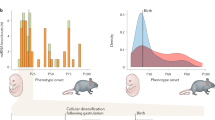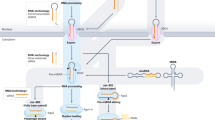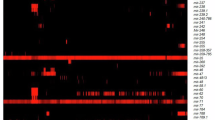Abstract
MicroRNAs (miRNAs) are a class of short (∼22-nt) noncoding RNA molecules that downregulate expression of their mRNA targets. Since their discovery as regulators of developmental timing in Caenorhabditis elegans, hundreds of miRNAs have been identified in both animals and plants1. Here, we report a technique for visualizing detailed miRNA expression patterns in mouse embryos. We elucidate the tissue-specific expression of several miRNAs during embryogenesis, including two encoded by genes embedded in homeobox (Hox) clusters, miR-10a and miR-196a. These two miRNAs are expressed in patterns that are markedly reminiscent of those of Hox genes. Furthermore, miR-196a negatively regulates Hoxb8, indicating that its restricted expression pattern probably reflects a role in the patterning function of the Hox complex.
This is a preview of subscription content, access via your institution
Access options
Subscribe to this journal
Receive 12 print issues and online access
$259.00 per year
only $21.58 per issue
Buy this article
- Purchase on SpringerLink
- Instant access to full article PDF
Prices may be subject to local taxes which are calculated during checkout






Similar content being viewed by others
References
Griffiths-Jones, S. The microRNA Registry. Nucleic Acids Res. 32, D109–D111 (2004).
Lee, R.C. & Ambros, V. An extensive class of small RNAs in Caenorhabditis elegans. Science 294, 862–864 (2001).
Lagos-Quintana, M. et al. Identification of tissue-specific microRNAs from mouse. Curr. Biol. 12, 735–739 (2002).
Lagos-Quintana, M., Rauhut, R., Lendeckel, W. & Tuschl, T. Identification of novel genes coding for small expressed RNAs. Science 294, 853–858 (2001).
Krichevsky, A.M., King, K.S., Donahue, C.P., Khrapko, K. & Kosik, K.S. A microRNA array reveals extensive regulation of microRNAs during brain development. RNA 9, 1274–1281 (2003).
Chen, X. A microRNA as a translational repressor of APETALA2 in Arabidopsis flower development. Science 303, 2022–2025 (2004).
Juarez, M.T., Kui, J.S., Thomas, J., Heller, B.A. & Timmermans, M.C. microRNA-mediated repression of rolled leaf1 specifies maize leaf polarity. Nature 428, 84–88 (2004).
Johnson, S.M., Lin, S.Y. & Slack, F.J. The time of appearance of the C. elegans let-7 microRNA is transcriptionally controlled utilizing a temporal regulatory element in its promoter. Dev. Biol. 259, 364–379 (2003).
Brennecke, J., Hipfner, D.R., Stark, A., Russell, R.B. & Cohen, S.M. bantam encodes a developmentally regulated microRNA that controls cell proliferation and regulates the proapoptotic gene hid in Drosophila. Cell 113, 25–36 (2003).
Hutvágner, G. & Zamore, P.D. A microRNA in a multiple-turnover RNAi enzyme complex. Science 297, 2056–2060 (2002).
Reinhart, B.J. et al. The 21-nucleotide let-7 RNA regulates developmental timing in Caenorhabditis elegans. Nature 403, 901–906 (2000).
Pasquinelli, A.E. et al. Conservation of the sequence and temporal expression of let-7 heterochronic regulatory RNA. Nature 408, 86–89 (2000).
Lagos-Quintana, M., Rauhut, R., Meyer, J., Borkhardt, A. & Tuschl, T. New microRNAs from mouse and human. RNA 9, 175–179 (2003).
Lim, L.P., Glasner, M.E., Yekta, S., Burge, C.B. & Bartel, D.P. Vertebrate microRNA genes. Science 299, 1540 (2003).
Yekta, S., Shih, I.H. & Bartel, D.P. MicroRNA-directed cleavage of HOXB8 mRNA. Science 304, 594–596 (2004).
Whiting, J. et al. Multiple spatially specific enhancers are required to reconstruct the pattern of Hox-2.6 gene expression. Genes Dev. 11, 2048–2059 (1991).
Brend, T., Gilthorpe, J., Summerbell, D. & Rigby, P.W. Multiple levels of transcriptional and post-transcriptional regulation are required to define the domain of Hoxb4 expression. Development 130, 2717–2728 (2003).
Erselius, J.R., Goulding, M.D. & Gruss, P. Structure and expression pattern of the murine Hox-3.2 gene. Development 110, 629–642 (1990).
van den Akker, E. et al. Axial skeletal patterning in mice lacking all paralogous group 8 Hox genes. Development 128, 1911–1921 (2001).
Bartel, D.P. MicroRNAs: genomics, biogenesis, mechanism, and function. Cell 116, 281–297 (2004).
Llave, C., Xie, Z., Kasschau, K.D. & Carrington, J.C. Cleavage of Scarecrow-like mRNA targets directed by a class of Arabidopsis miRNA. Science 297, 2053–2056 (2002).
Kasschau, K.D. et al. P1/HC–Pro, a viral suppressor of RNA silencing, interferes with Arabidopsis development and miRNA function. Dev. Cell 4, 205–217 (2003).
Niwa, H., Yamamura, K. & Miyazaki, J. Efficient selection for high-expression transfectants with a novel eukaryotic vector. Gene 108, 193–199 (1991).
Chung, J.H., Whiteley, M. & Felsenfeld, G. A 5′ element of the chicken β-globin domain serves as an insulator in human erythroid cells and protects against position effect in Drosophila. Cell 74, 505–514 (1993).
Araki, K., Araki, M., Miyazaki, J. & Vassalli, P. Site-specific recombination of a transgene in fertilized eggs by transient expression of Cre recombinase. Proc. Natl. Acad. Sci. USA 92, 160–164 (1995).
Dietrich, S., Schubert, F.R. & Lumsden, A. Control of dorsoventral pattern in the chick paraxial mesoderm. Development 124, 3895–3908 (1997).
Hamburger, V. & Hamilton, H.L. A series of normal stages in the development of the chick embryo. J. Morphol. 88, 49–92 (1951).
Acknowledgements
We thank S. Dymecki for plasmids; A. Abney and L. Du for pronuclear injections of the transgenes; members of the laboratories of C.J.T., C. Cepko, S. Dymecki and P.A.S. for discussions and advice; and A. Brent for critical reading of the manuscript. This work was supported by a grant from the March of Dimes to C.J.T., and by a US National Institutes of Health MERIT award and grants from the National Cancer Institute to P.A.S. J.H.M. and M.T.M. are supported by postdoctoral fellowships from the National Institutes of Health and the Cancer Research Institute, respectively.
Author information
Authors and Affiliations
Corresponding authors
Ethics declarations
Competing interests
The authors declare no competing financial interests.
Rights and permissions
About this article
Cite this article
Mansfield, J., Harfe, B., Nissen, R. et al. MicroRNA-responsive 'sensor' transgenes uncover Hox-like and other developmentally regulated patterns of vertebrate microRNA expression. Nat Genet 36, 1079–1083 (2004). https://doi.org/10.1038/ng1421
Received:
Accepted:
Published:
Issue date:
DOI: https://doi.org/10.1038/ng1421
This article is cited by
-
Nr6a1 controls Hox expression dynamics and is a master regulator of vertebrate trunk development
Nature Communications (2022)
-
Molecular features and vulnerabilities of recurrent chordomas
Journal of Experimental & Clinical Cancer Research (2021)
-
The roles of microRNAs in mouse development
Nature Reviews Genetics (2021)
-
MiR-10a and HOXB4 are overexpressed in atypical myeloproliferative neoplasms
BMC Cancer (2018)
-
Transcription and microRNA Profiling of Cultured Human Tympanic Membrane Epidermal Keratinocytes
Journal of the Association for Research in Otolaryngology (2018)



